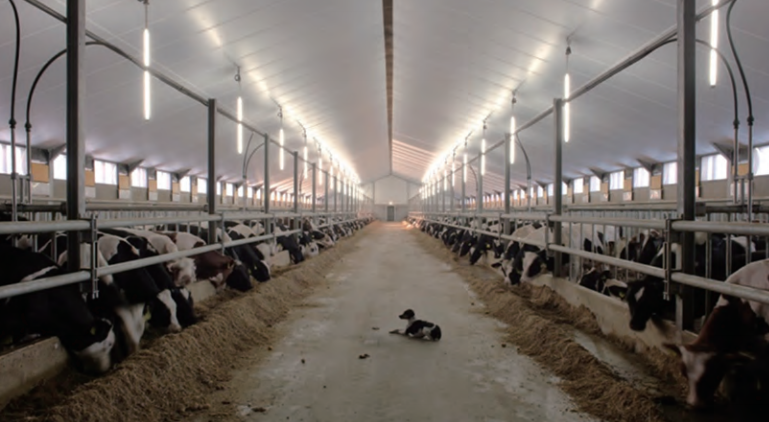Cow Lighting Management: Cow Shed Lighting

Directory:
1. Introduction
2. Common Misconceptions in Cow Lighting Management
3. Biological Mechanisms of Light Influence
4. Lighting Requirements for Different Herd Categories
5. Impacts of Lighting on Production Performance
6. Cow Lighting System Recommendations
Proper Cow lighting management significantly enhances milk yield and stimulates reproductive performance in dairy cows. While many Cow Shed operators recognize the importance of cow lighting, inconsistent results persist due to a lack of understanding of cows' specific photic requirements. This article synthesizes foundational knowledge on cow lighting needs, debunks common misconceptions, and provides actionable recommendations for optimizing cow shed lighting systems.
1. Introduction
Lighting profoundly influences animal physiology, metabolism, and behavior. For dairy cows, extended photoperiods (16 hours of light, 8 hours of darkness) have been proven to boost milk production by 7–10% through increased feed intake and hormonal regulation. Despite advancements like LED adoption, many cow shed rely on outdated practices, such as 24-hour lighting or inconsistent schedules, undermining productivity. This article addresses key lighting principles and system design tailored to bovine biology.
2. Common Misconceptions in Cow Lighting Management
2.1 Lighting Has Minimal Impact on Milk Yield
Lighting directly affects feed intake and hormonal balance, offering a higher return on investment (ROI >1:50) compared to comfort improvements like cooling systems (ROI ~1:3).
2.2 Continuous Bright Lighting Maximizes Productivity
Studies show that 24-hour lighting disrupts circadian rhythms, causing hormonal imbalances. Optimal results are achieved with 16 hours of light (200 lux) and 8 hours of darkness.
2.3 Energy Efficiency Trumps Spectral Quality
While energy-saving LEDs are cost-effective, blue-dominant spectra (common in low-cost LEDs) fail to meet cows’ visual needs. Cows are more sensitive to red wavelengths, requiring lighting that mimics natural sunlight.
3. Biological Mechanisms of Light Influence
Light signals received by retinal photoreceptors regulate melatonin secretion via the hypothalamus-pineal axis. Reduced melatonin during light phases stimulates prolactin (PRL) and insulin-like growth factor (IGF-1), critical for milk synthesis and growth. Conversely, darkness promotes melatonin release, synchronizing biological rhythms.
4. Lighting Requirements for Different Herd Categories
4.1 Lactating Cows
16L:8D cycle: Maximizes feed intake and milk yield.
Uniform illumination: Avoid shadows to prevent stress (cows perceive shadows as impassable "black holes").
4.2 Dry Cows
8L:16D cycle: Enhances subsequent lactation responsiveness and dry matter intake (+12%). Natural lighting often suffices.
4.3 Heifers
16L:8D cycle: Accelerates growth, mammary development, and sexual maturity. Transition to short photoperiods 2 months pre-calving.
5. Impacts of Lighting on Production Performance
Milk Yield: Extended light exposure increases feed intake, driving a 7–10% rise in milk output without altering fat/protein content.
Reproductive Efficiency: Supplemental winter/fall lighting shortens calving intervals, reduces insemination attempts, and lowers ovarian disorder incidence.
6. Cow Lighting System Recommendations
6.1 Spectral Quality: Prioritize LEDs with red wavelengths to align with bovine vision and support vitamin D synthesis.
6.2 Uniformity: Use vertically mounted fixtures to eliminate shadows and ensure even distribution.
6.3 Automation: Install sunrise/sunset timers for seamless photoperiod transitions and energy savings.
6.4 Durability: Select waterproof, dust-resistant fixtures with low light decay.
6.5 Worker-Friendly Design: Implement red-blue dual lighting for nighttime operations to minimize cow disturbance.
Photoperiod management is a low-cost, high-impact tool for cow shed. Key strategies include adopting species-specific lighting spectra, automating cycles, and tailoring protocols to lactation stages. By integrating these practices, cow shed can enhance productivity, animal welfare, and profitability.
7. Related Products


8. Related Solution & Science
9. Related Blog
Swine Lighting System Standards: best Light Fixtures for Swine Building
Led Swine Lighting: The Application of Light Fixtures for Swine Barns
Pig Farms Lighting Design: Best Light for Pig House
10. Contact Ceramiclite
